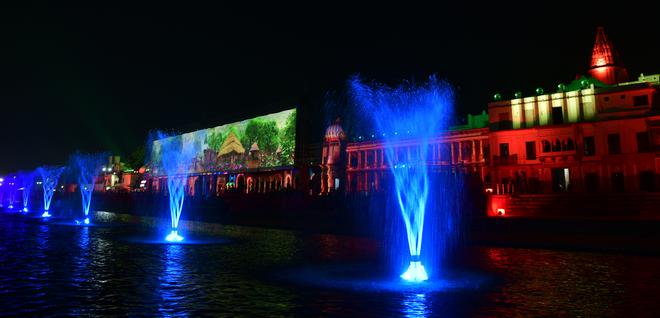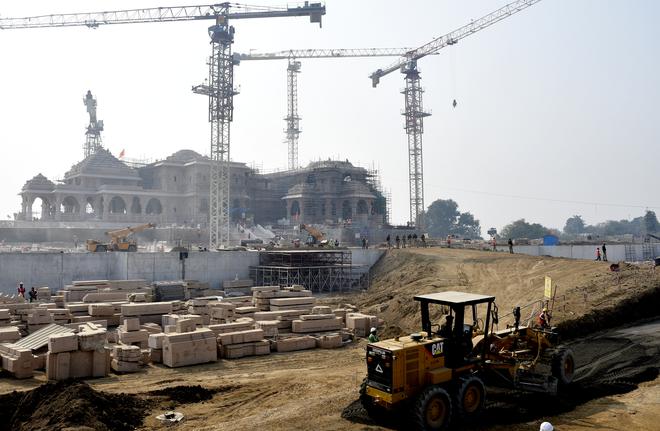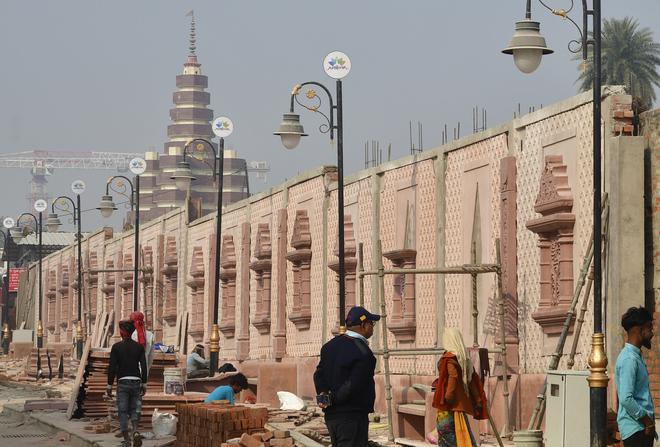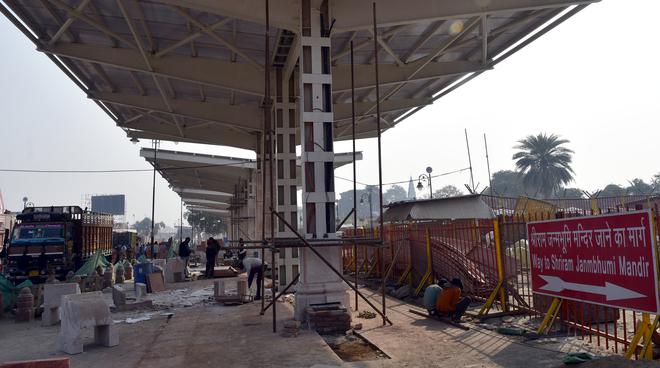It’s the twilight hour. The noise of earth movers and stone-cutting machines melds with the devotional songs being played at every second house and shop in Ayodhya, a two-hour drive from Uttar Pradesh’s capital, Lucknow. At 6 p.m., the small makeshift temple within bulletproof glass, dedicated to Ram Lalla (the child Ram), which currently sits at the Ram janmabhoomi (birthplace), is closed. Devotees move to the other side of the city, towards the ghats of the Sarayu river. Here, an aarti (worship) of the river is performed, followed by a sound and light show of the Ramayana, the story of Ram from his birth to his return to Ayodhya.
This shift in the tide of tourists gives workers the time and space to complete the construction of roads — Bhakti path, Ram path, and Janambhoomi path — leading to several religious monuments within a 5-kilometre radius in Ayodhya. The Janmabhoomi path culminates in the 360-foot tall, 235-ft wide Ram temple, its stone being polished on a war footing, for the inauguration by Prime Minister Narendra Modi on January 22.
The dust from construction hangs heavy in the air, over the area Hindus believe is the birthplace of Ram, considered the seventh incarnation of Vishnu. Spread across 2.7 acres, the temple that will occupy 30% of this space, with the rest left for green cover, is, for many, a big victory for the Hindus. For several others, the demolition by Hindutva groups of the 16th-century Babri Masjid, which stood at the site, is a black mark on India’s secular constitutional commitment.
In November 2019, a Constitution Bench of the Supreme Court permitted the construction of the Ram temple in Ayodhya at the disputed site. Soon after the judgment, the Vishva Hindu Parishad (VHP), an outfit of the Rashtriya Swayamsevak Sangh, which was at the forefront of the Ram Janmabhoomi movement that began in the early 1980s, began seeking donations for the construction of the temple. About 20 lakh volunteers reached out to 12.7 crore Hindu families across India, collecting ₹3,500 crore in donations.

A city’s makeover
In Ayodhya, workers are busy plastering the facades of the houses and shops partially demolished to widen the roads, in some cases, against the wishes of the owners. The buildings are being uniformly painted cream and saffron, with a white temple spire drawn on each. The shutters of the shops around the temple are dark brown colour with Hindu-themed artwork: the swastika, saffron flag, bow and arrow, conch, mace, or just Shri Ram in Devanagari script.
Saishwari Gaonkar, 26, from Goa is visiting Ayodhya with her family. They gather near the I-love-Ayodhya selfie point to click pictures. Gaonkar is happy with her trip but complains that the line to deposit phones and other belongings in the locker outside is way too long. “Many people even missed their trains and buses as it took them hours to collect their stuff. The authorities must do something about it,” she says, adding that cleanliness is another miss in the city.
Kavita Naik, her mother-in-law, interrupts her to add that this was just the beginning of a ‘New Ayodhya’. “Things will only get better,” she feels. Her daughter-in-law nods.
Yogesh Bhai Shah, 62, from Surat, who is on a 10-day trip to Ayodhya with 200 people from his city, says, “The Sarayu ghats are even better than the Varanasi ghats.”
According to the Uttar Pradesh government, Ayodhya, which was part of the Faizabad district until 2018, is witnessing a facelift like no other city in India has ever witnessed. Under the Ayodhya master plan-2031 and Vision Ayodhya-2047, up to 250 projects worth more than ₹80,000 crore are simultaneously being executed by 34 executive agencies. The aim is to make Ayodhya a global holy city. A large chunk of this fund is being given by the Centre.
This development includes construction of a new township over 1,200 acres, which will be developed with nearly ₹2,200 crore in the next five years. The city now has a new airport and a renovated railway station. To keep the young and restless entertained, the Sarayu will have speed boat rides. Soon, there will be a museum, a spiritual theme park, and a Ramayana forest.
At its heart
“Humare liye usi plot par mandir banana zaruri tha jahan kisi samay wo teen gumbado wala dhancha khada tha. Kyunki wahi plot number 583 ka waad humne Supreme Court me jeeta tha (It was important for us to build the temple on the same plot where that three-domed structure was standing. Because we won the case for that same plot number 583 in the Supreme Court),” Champat Rai, a senior VHP leader and general secretary of the Shri Ram Janmabhoomi Teerth Kshetra (temple trust), said at a press conference.
Rai said that the Ram temple will have its own power station, sewage, and water treatment plant, so the city’s civic system would not be burdened by its presence. “Built in the mix of both Nagara and Dravidian style of architecture, the temple is being constructed without cement and iron to make its life longer,” he said, adding that artisans from across India had been at work. While the architect was from Gujarat, sculptors from Odisha had carved works in sandstone, those from Andhra Pradesh and Tamil Nadu had done the woodwork; brass had been sourced from U.P., teak from Maharashtra, and granite from Telangana and Karnataka.

The idol of the child Ram will soon be placed within the sanctum sanctorum, but it will take another year for the complete plan to come to fruition. For the convenience of pilgrims, the temple will have rest points, lockers, drinking water and toilet facilities, as well as wheelchairs.
Tourist influx
Ayodhya is also now witnessing a boom in the hospitality sector. After the inauguration, government authorities peg the monthly tourist inflow at 45 lakh. In fact, between December 31 and January 1, city police had prepared a plan for 50 lakh people here.
On New Year’s Eve, Ritesh Agarwal, founder of OYO rooms, had tweeted that in one of the highest spikes, 80% new users on his platform were searching for stays in Ayodhya, followed by Goa and Nainital. For January 22, five tent cities are being set up in Bagh Bijesi, Guptar Ghat Ram Katha Park, Karsewakpuram, and Brahmakund. Later, these may become permanent.
Sezer Turkmen, 71, from Turkey, is on a two-day trip to Ayodhya as part of his year-long Asia tour. A civil engineer, he walks between 45,000 and 50,000 steps daily to traverse every part of the cities he is visiting. “I was using a couch-surfing app which suggested I visit Ayodhya. I read about the city and was curious to witness its culture,” he says. He loves the artwork on the temples, but is sardonic about the bringing down of the mosque to build a temple.

Ayodhya’s people
Raju Kumar, 47, who runs a makeshift tea shop on Guptar ghat, believed to be the spot where Ram subjected himself to a jal samadhi (water burial), is calculating his cash in hand. In a few days he may have to vacate his shop and home, situated in a slum next to the ghat. Kumar, with his wife Anita, shifted to Ayodhya from Bihar’s Gopalganj two decades ago in search of work.
“This entire city is being demolished to build a new one. To broaden roads, they are mercilessly demolishing shops and houses. I am told by officials that my shop and house fall in the way of development so I should vacate both. I know that our shop was an encroachment, but where we will go now?” says Anita. Her husband earns ₹500-800 daily by selling tea, soft drinks, and litti-chokha, a dish of wholewheat dumplings with potato, popular in Bihar. She handles the shop when he is away to work on the boat that the couple had purchased with their savings.
At his shop, Abhishek Shukla, a student pursuing B.Tech, sits with a friend sipping tea. They say everyone is bearing the brunt of development. “I read somewhere that they may demolish the top floors of multi-storey houses near the airport. I also live there. But we are getting an airport, so we can bear some pain,” says Shukla.
Unlike Kumar, Pradeep Singh, 22, who moved to Ayodhya from Gonda in Bihar in search of work, is hopeful of finding better employment opportunities. Singh bought an e-rickshaw and a cart on which his aunt and uncle sell snacks. With the influx of tourists, his income has doubled.
Rita Devi, who sells souvenirs, bangles, and toys near Hanumangadi temple, says sales have gone up five times since the road was broadened and people were given space to stand on the pavements. She is happy that the Ram temple is being constructed and believes that the city will now see tourist flow through the year, unlike in the past when crowds would come only during annual fairs. “Modi and Yogi have developed Ayodhya like Delhi,” says Devi, who earlier paid a rent of ₹500 for the shop and is now paying ₹3,000 after the makeover.
Narain Gupta, who sells prasad near the Hanuman temple, says 30% of his shop was demolished when the road was broadened, but he has no regrets as it was done for pilgrims.
Pankaj Gupta, president, U.P. Udyog Vyapar Pratinidhi Mandal (Ayodhya Dham), who is also associated with the Bharatiya Janata Party (BJP), claims that tourism is yet to reach its peak in Ayodhya. “In my childhood, the tourist flow in Ayodhya was in hundreds. In my college days, it grew to a few thousands. Since the 2019 judgment, the number has increased to 20,000 a day. In 2023, I am sure at least 1.5 lakh people will have come to this holy town,” says Gupta, who rubbishes claims that houses and shops are being demolished mercilessly. He claims he, along with traders’ association members, met officials from the Ayodhya Development Authority (ADA) in 2023 and requested them to ensure that rehabilitation of those losing shops and homes be done. But he adds there is no space for encroachers. “All those with papers will be compensated.”

Udal Singh from Karauli in Rajasthan has been working in Ayodhya since May 2023. He carves stones and is giving the final touches to the giant temple entrance at the Birla dharamshala (guest house) side. Elated to be working on the Ram temple, he says he had also carved designs at Ujjain’s Mahakaleshwar temple. Away from home for months, Singh is working to ensure his four children get a good education and a better life. He hopes to bring his family to see the temple soon.
As Singh’s team carves out a Ganesha idol, stone dust flies. Passers-by cover their noses and eyes. Policemen guarding the entrance wear masks. Anil Sonkar, on special duty in Ayodhya, jokes drily, “No matter how much pollution there is here, it will always be less than Delhi.”
Iqbal Ansari, one of the main litigants in the Ram Janmabhoomi-Babri Masjid land suit, lives a few metres away from the Ram temple. For him, the construction symbolises a closure of the decades-long dispute between Hindus and Muslims. “Ayodhya is a tolerant city. I hope this tolerance prevails till eternity,” he says.






